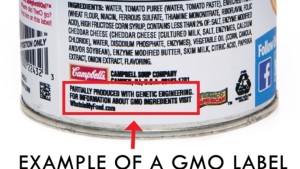Three Marketing Implications of the GMO Labeling Law
With a nationwide GMO labeling bill now signed into law, brands are attempting to sort out what the new requirements will mean for their products. Although the FDA has until summer 2019 to establish the full rules for the law—and even longer to enforce them—the length of supply chains means that brands are already pondering how to respond. Although it’s very early to determine the best strategy, for the purpose of initial thought, here are three initial approaches for brands that will have to navigate the challenges presented by the GMO Labeling Law.
1. Minimal Labeling Adjustments

Although details remain to be articulated about the GMO labeling law, we know that it will allow for some relatively minimal labeling adjustments: foods containing GMOs will be able to be disclosed by placing a QR code, website URL, or phone number which consumers can use for full disclosure. For brands that need to keep re-labeling costs as minimal as possible, this simple addition should be simple to accomplish and unobtrusive. The risk, of course, is that consumers will come to perceive such foods as inferior or unsafe. For brands that require a minimal investment and do not place a high value on communicating an all-natural value, however, a minimal approach of pairing a QR code with a simple disclosure website may be the best option.
2. Reformulation
For some brands, the need to disclose GMO ingredients may accelerate inclinations to remove such ingredients from their products. If your company was already pondering the value of going non-GMO, labeling requirements may make the business case for doing just that more compelling. However, it is essential to consider all the factors involved and not rush into what will be a complex process, involving supply chains, pricing concerns, and marketing. It is important to remember that conventional brands that have gone non-GMO (for example, Cheerios) have not always seen the success they hoped, and the new labeling requirements may not create the negative consumer perception some have feared. Although certain brands will and should consider reformulation, it is not a decision anyone will make lightly.
3. Education Plus Labeling

Finally, for brands willing to invest a little more on the marketing side rather than in reformulation, the required labeling can be paired with consumer education to help increase consumer confidence in your products. Although it’s easy to see the negatives to GMO labeling for brands, there’s also an obvious positive to disclosure using a URL or QR code: it sends people to your website. That website should not just be a simple disclosure of GMO ingredients, but instead should be a place to demonstrate strong transparency and promote the safety and benefits of your GMO ingredients. The site needs to be content rich, science based, and accessible to any consumer. It should also follow best practices for online marketing by driving interested visitors to the rest of your site, and prompting them to initiate further contact with you through email or social media. A coordinated campaign for transparency and education around GMO labeling could bring respect from consumers and good media coverage, because despite the ongoing presence of GMOs in your products, your audience would recognize your concern for their health and safety. An approach like this is already being practiced by Campbell’s, with a transparency portal that they launched in coordination with announcing their support for GMO labeling. Brands like Campbell’s that invest in developing a thorough educational campaign regarding their GMO ingredients could then find GMO labeling to be a net benefit.
As your company grapples with the implications of the new GMO labeling law, make sure your marketing partners understand the consumer dynamics and regulatory options. As the Food Marketing Experts, MarketPlace is well positioned to help you navigate this new reality of the industry. If you would like to discuss your particular situation, give us a call or email.
